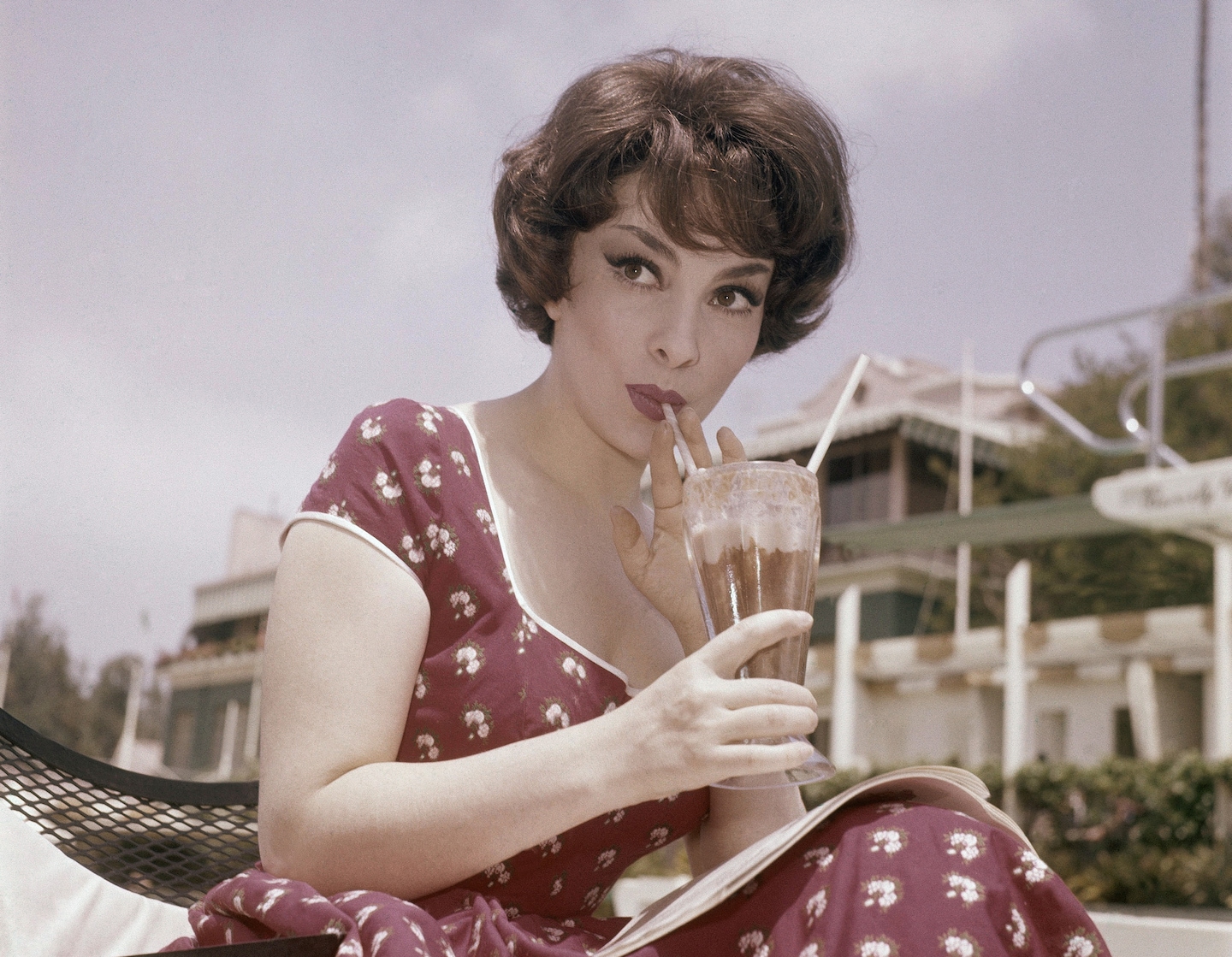But when Time magazine examined the might of Italian film production in 1954, it did not put Rossellini or De Sica on the cover.
Instead it featured Gina Lollobrigida, a ruby-lipped bombshell encased in clinging gowns, whose presence in comedies, romances and adventures powered a rebellion against neorealism.
Ms. Lollobrigida, who died Jan. 16 in Rome at 95, was for a time an international sensation with few equals.
In the estimation of actor Humphrey Bogart, her allure made “Marilyn Monroe look like Shirley Temple.” Life magazine called “La Lollo” — as she was nicknamed — “the most fetching argument ever advanced for liberal immigration policies.”
For New York Times movie critic Bosley Crowther, she was “the original Italian over-stuffed star,” a pneumatic precursor to Sophia Loren, who would soon be ensconced in the public imagination as the quintessential Italian sex goddess.
Ms. Lollobrigida (pronounced lo-lo-BRIDGE-eeh-dah) was among the European screen beauties, along with Brigitte Bardot and Anita Ekberg, whose charms stirred the fantasies of a generation of moviegoers.
In a heyday that spanned a quarter-century and more than 50 films, Ms. Lollobrigida had a decidedly mixed reputation as an actress.
“She is handicapped by a lack of intensity, lack of presence,” film historian David Shipman noted. He likened her sex appeal to the one dimensionality of an advertisement billboard.
She began her career on a lark in 1946, when a movie director eyed the onetime art student on the streets of Rome and was besotted.
And it was a photo of Ms. Lollobrigida in a bikini that proved sufficient to entice billionaire industrialist and film producer Howard Hughes to fly her to Hollywood in 1950.
He kept her a virtual prisoner for weeks in a fancy hotel, she later said, until she agreed to a contract. She said that she refused his sexual advances and that he, in return, made her prohibitively expensive for other filmmakers in the United States.
As a result, the younger Loren conquered Hollywood first. Ms. Lollobrigida, who often stoked their rivalry, would later cattily remark to Life: “We are as different as a fine race horse and a goat.”
Her ascent continued, but in European movies or European American co-productions such as “Beat the Devil” (1953) and “Trapeze” (1956).
The former is a shaggy-dog caper about con artists in which Bogart and Ms. Lollobrigida were cast as husband and wife.
The latter featured her as a circus performer whose wiles and ambition threaten to break up the partnership of aerialists played by Burt Lancaster and Tony Curtis.
Even after she escaped Hughes, Ms. Lollobrigida was long subjected to the cinematic leer. In “Solomon and Sheba” (1959), she performed, as Sheba, a memorable Technicolor pagan dance to the delight of co-star Yul Brynner as Solomon.
Her tub scene was the highlight of an otherwise wan World War II movie with Frank Sinatra, “Never So Few” (1959). In the drama “Go Naked in the World” (1961), she was a call girl wooed by a construction tycoon’s son (Anthony Franciosa), and she played a nurse recruited for a murder scheme in “Woman of Straw” (1964) co-starring Sean Connery.
Her career diminished gradually with farces such as “Strange Bedfellows” (1965), opposite Rock Hudson, “The Private Navy of Sgt.
O’Farrell” (1968), with Bob Hope, and “Buona Sera, Mrs. Campbell” (1968), about an Italian woman entangled with three ex-GIs (Telly Savalas, Peter Lawford and Phil Silvers).
Over the years, Ms. Gina Lollobrigida had acquired a reputation as quarrelsome and demanding, a performer with insatiable vanity and unbridled desire for control over the set. She was also litigious, filing as many as 10 lawsuits at a time.
She sued producers for what she alleged were broken promises and sicced her lawyers on advertisers and publications she claimed had used her image without permission.
According to Time, she prevailed over an Italian film critic for his disparaging description of her “udder.”
In interviews, Ms. Lollobrigida presented herself as one of life’s indomitable survivors: an Italian country girl who endured wartime hardship, sexual assault, deceitful producers and a vicious entertainment press.
When her screen career dimmed, she moved on with vigor. She became a sculptor, and she published books of her photography.
“I may not be Cartier-Bresson, but I can do something good,” she later told the New York Times. She made a short film documentary about Cuban leader Fidel Castro in 1972.
She also was a fundraiser for U.N. humanitarian missions, work that led to her failed attempt in 1999 to win one of Italy’s seats in the European Parliament.
Through it all, she remained “La Lollo,” managing to spice up scandal sheets and celebrity magazines with private travails brought on by her self-professed “weakness for young men.”
As an octogenarian, she sued a boyfriend 25 years her junior who she alleged had orchestrated an unauthorized marriage to siphon off her considerable fortune, estimated in the tens of millions of dollars.
Her son tried unsuccessfully to have her declared mentally unfit to handle her business affairs. She emphasized her independence by comparing herself to the Colosseum, declaring, “I will never crumble and never collapse.”
The second of four daughters, Luigia Lollobrigida was born in the Sabine mountain town of Subiaco on July 4, 1927. Her father lost his furniture factory in an Allied bombing raid during World War II and moved the family to Rome, 50 miles to the west, where he began selling black-market cigarettes and military blankets.
“We were so poor I made my shoes from stable straw,” she later told the Weekly World News. After Italy’s surrender, she sang and sold sketches to American GIs.
She used the money she earned to pay for singing lessons and won a scholarship to the Academy of Fine Arts in Rome.
A chance encounter with a studio official led to roles as a movie extra and then to gradually bigger parts. She also worked as a model and won the title of Miss Rome before placing third in the Miss Italy competition.
In 1949, she married a Yugoslav doctor, Milko Skofic, who became her manager. He took the ribald publicity photos of 23-year-old Ms. Lollobrigida that intrigued Hughes, who promptly provided her with a single, one-way ticket to Los Angeles.
Hughes had her chauffeured to a luxury hotel, where guards were stationed outside her door and she was allowed no mail or phone calls. He told her to leave her husband and, to press the point, assigned her divorce scenes for her screen test.
Weary after six weeks in gold-plated captivity, Ms. Lollobrigida said she broke down during a 2 a.m. meeting with Hughes and signed a contract. Only then was she allowed to fly home.
Ms. Lollobrigida advanced up the marquee in European films. She made a bodice-busting impression in “Fanfan la Tulipe” (1952), a swashbuckler starring the French star Gérard Philipe.
She had a breakthrough the next year, playing a sparky, barefoot peasant in the vivacious comedy “Bread, Love and Dreams” opposite De Sica, who was also a noted actor and portrayed the uptight but smitten Carabinieri officer.
She commanded $48,000 for the film, a fee that was doubled for the equally popular sequel “Bread, Love and Jealousy” (1954).
When she held out for half the profits of the second sequel, “Scandal in Sorrento” (1955), Loren was hired instead and mamboed her way to Hollywood.
Meanwhile, Ms. Lollobrigida drew headlines more for her romances than her movie roles. In the 1960s, she had a brief engagement to New York real estate heir George S.
Kaufman and a torrid affair with South African heart surgeon Christiaan Barnard, whom she later called a “cheap publicity seeker” for revealing that she had once driven him to his hotel in a Jaguar while wearing only a mink coat. She said she tried to seduce Hudson, who was gay and who, she later told CNN host Larry King, “fell asleep” in bed.
In 2006, Ms. Lollobrigida said she called off a planned marriage to Javier Rigau y Rafols, a Spanish businessman. But in 2010, Rigau staged the wedding in Barcelona with a proxy “stand-in” bride. She called the matter a “horrific and vulgar fraud” perpetrated by a fortune hunter.
Rigau produced witnesses who testified to her having signed authorization for a proxy. After a court in Rome ruled against Ms. Lollobrigida in 2017, she continued to seek an annulment.
Meanwhile, as her son, Andrea Milko Skofic, challenged her competence, she was often seen in the company of her new manager, Andrea Piazzolla, who was 60 years her junior and whom she called “the best person I have ever found in my life until now.”
Gennaro Sangiuliano, Italy’s culture minister, announced the death but gave no further details. A complete list of survivors was not immediately available.
Ms. Lollobrigida once told Vanity Fair magazine that, whatever her public image, she saw herself as essentially a solitary soul, needing little but art. “I have never made any compromise, remaining independent and always alone,” she said in 2015. “My strength is my free spirit, and my great imagination gives me strength and vitality.”








